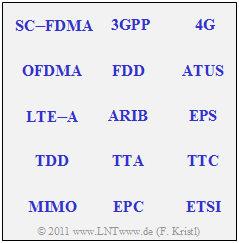Difference between revisions of "Aufgaben:Exercise 4.1: General Questions about LTE"
| Line 59: | Line 59: | ||
{{ML-Kopf}} | {{ML-Kopf}} | ||
| − | '''(1)''' | + | '''(1)''' Correct are the <u>answers 1 to 3</u>, which also stand for the most important improvements through LTE: |
| − | * | + | *Low power consumption at base stations is explicitly wrong, because the aim is to keep power consumption at the terminals as low as possible, for which even increased power consumption at base stations is accepted. |
| − | '''(2)''' | + | '''(2)''' Correct are the <u>answers 2 and 4</u>: |
| − | * | + | * The decisive reason for the duplex–gap is to create a safety buffer between uplink and downlink. |
| − | * | + | *But also answer 4 is correct: radio microphones have been and are still operated with frequencies in the range around 800 MHz, i.e. at frequencies that are now needed for LTE. |
| − | * | + | *When LTE is finally extended to cover entire areas, there will be interference with less powerful radio microphones. |
| − | * | + | *In addition, the use of event technology on the LTE frequencies will be prohibited for the years after 2015. Among other things, this is also why there is this duplex gap, but that is not the real reason, it is a useful side effect. |
| − | '''(3)''' | + | '''(3)''' Correct are the <u>three first answers</u>: |
| − | *OFDMA | + | *OFDMA is used in the downlink of LTE, SC–FDMA in the uplink. |
| − | * | + | *Multiple-input multiple-output (MIMO) systems are used more frequently in mobile communications, and not only in LTE. |
| − | * | + | *In fact, CDMA is also used for LTE, but only for control channels. |
| − | + | '''(4)''' Correct are the <u>answers 1, 2 and 4</u>: | |
| − | '''(4)''' | + | *The higher-frequency 2600 MHz range is particularly interesting for large cities due to conditions imposed by the federal government and because of the lower range. |
| − | * | + | *The 800 MHz range, which consists of paired frequencies only, will be used primarily for rural areas. |
| − | * | ||
{{ML-Fuß}} | {{ML-Fuß}} | ||
Revision as of 15:18, 10 July 2020
Since 2011, mobile communications systems have already reached the fourth generation, without serious delays, as was the case with the second generation of mobile communications (GSM) and even more so with the third generation (UMTS). Currently (2017) "5G" is the all-dominant buzzword. However, the author does not allow himself any more precise statements about the time of introduction than "very soon" or "as soon as possible". More detailed information can be found here.
The development of new "releases" is constantly being driven forward by 3GPP. This international consortium, which includes all major mobile operators and manufacturers worldwide, will continue to play a prominent role in mobile communications in the future.
LTE has been offered commercially since 2011, especially for sparsely populated rural areas without sufficient DSL broadband connections. This 4G mobile communications standard is gradually becoming more widespread.
Notes:
- This task belongs to the chapter Allgemeines zum Mobilfunkstandard LTE.
- The chart shows some LTE-relevant terms. However, there is no direct reference to the task.
Questionnaire
Sample solution
(1) Correct are the answers 1 to 3, which also stand for the most important improvements through LTE:
- Low power consumption at base stations is explicitly wrong, because the aim is to keep power consumption at the terminals as low as possible, for which even increased power consumption at base stations is accepted.
(2) Correct are the answers 2 and 4:
- The decisive reason for the duplex–gap is to create a safety buffer between uplink and downlink.
- But also answer 4 is correct: radio microphones have been and are still operated with frequencies in the range around 800 MHz, i.e. at frequencies that are now needed for LTE.
- When LTE is finally extended to cover entire areas, there will be interference with less powerful radio microphones.
- In addition, the use of event technology on the LTE frequencies will be prohibited for the years after 2015. Among other things, this is also why there is this duplex gap, but that is not the real reason, it is a useful side effect.
(3) Correct are the three first answers:
- OFDMA is used in the downlink of LTE, SC–FDMA in the uplink.
- Multiple-input multiple-output (MIMO) systems are used more frequently in mobile communications, and not only in LTE.
- In fact, CDMA is also used for LTE, but only for control channels.
(4) Correct are the answers 1, 2 and 4:
- The higher-frequency 2600 MHz range is particularly interesting for large cities due to conditions imposed by the federal government and because of the lower range.
- The 800 MHz range, which consists of paired frequencies only, will be used primarily for rural areas.
